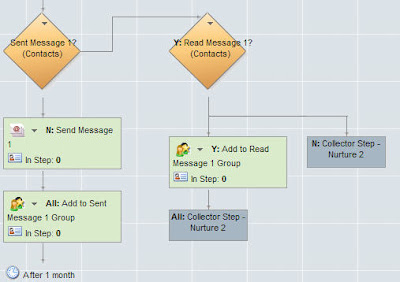So let's look at building a Program that does that.
 Essentially, this nurture Program is a very simple chain of "attempt to send a message" blocks that send a message if a person has never been sent it, but skip if the person has been sent it. Much of this could be done with Decision Rules that evaluate whether the person has received a specific email (or just rely on emails never being sent to the same person more than once), but that ignores the fact that often one message can be communicated in many different forms. Let's say it's an offer for a free whitepaper - there may be 4 or 5 different emails that offer this whitepaper.
Essentially, this nurture Program is a very simple chain of "attempt to send a message" blocks that send a message if a person has never been sent it, but skip if the person has been sent it. Much of this could be done with Decision Rules that evaluate whether the person has received a specific email (or just rely on emails never being sent to the same person more than once), but that ignores the fact that often one message can be communicated in many different forms. Let's say it's an offer for a free whitepaper - there may be 4 or 5 different emails that offer this whitepaper.So, to solve that problem, instead we use Contact Groups to manage whether a person has been sent a particular message. If they have, they skip that block, if they have not, they are sent that message. Any time a person is sent a message that is used in nurturing, they are added to the appropriate group. The Decision Rules you see in this flow for "Sent Message 1?" are evaluating whether the person is a member of the associated Contact Group. You can also add them to a "Read Message X" group if they open or click on the email, if you choose, and that helps significantly for building good analytics around your nurturing program, which we'll look at later.

Once you have the technique for one messaging block, just repeat with as many messaging blocks as you have content for. At the end of the program, wait for 30 days, then route all members back to the start. They will cycle through this Program indefinitely, but they will only receive any message in it once.
When you have any new content, add it into the Program as another messaging block, and everyone in being nurtured will receive that message when they are next ready to receive a nurture message.
Now you have a continuously running nurture Program that you can add your contacts into. New inquiries, old leads, contacts who are not quite ready for a sales call; all are great candidates for nurturing.


2 comments:
hmm... the only issue is that you have people running indefinitely through a program. If you go this route, I would somehow check if the contact going through the program was associated to an Opportunity from the CRM or had a certain lead status from the CRM and then remove them based on this criteria.
Good point Chad - agreed. I was maeaning to write a post about bringing in data from remote systems into Eloqua in order to either add them to programs or remove them from nurture programs based on status. I'll tie it back to this post when I do. Thanks for the comment.
Post a Comment